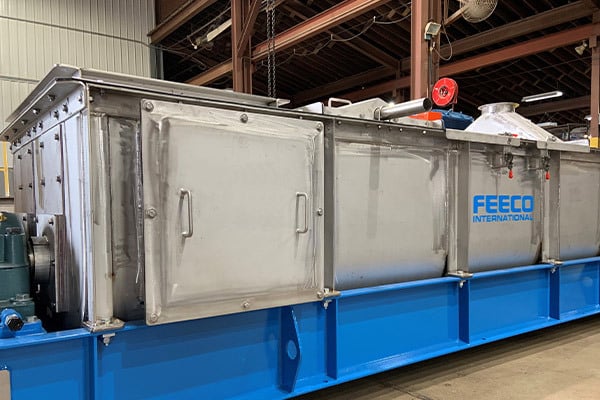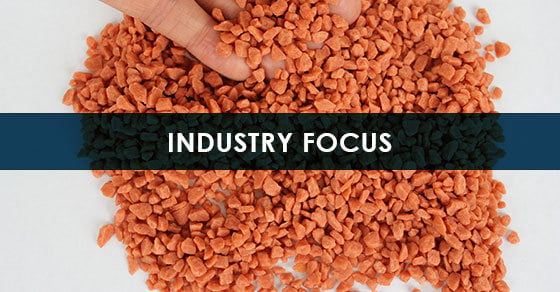Despite a challenging agriculture market, potash, the principal source of potassium fertilizers, is expected to see expanded demand in the coming years as feeding the growing population becomes an ever-more-pressing global issue.
While potash producers already put considerable effort into managing product quality, they will likely be amplifying their efforts to reduce waste and minimize losses through improved production techniques as potash becomes more valuable. One way in which producers can maximize product value is by discouraging attrition, or the generation of dust, through the inclusion of a glazing step in the production line.
What is Potash Glazing and Why is it Necessary?
Attrition is the degradation of product resulting in dust and fines. Dust not only makes handling and transporting potash difficult, but it also lowers product value and raises product loss, making attrition management critical.
Potash is notoriously prone to attrition, particularly when it has been processed into a granular fertilizer product via roll compaction; because granules produced in a roll compactor are jagged and irregular, granule edges are more likely to rub together and break down into dust during handling.
While the generation of dust is problematic in itself, dust also leads to another major problem; caking is more likely to occur when dust is present, further degrading the product and presenting a new set of issues such as workplace hazards, flowability challenges, and more.
Glazing, also commonly referred to as polishing or conditioning, is a finishing step utilized in the production of potash fertilizers in order to reduce the potential for attrition to occur. Glazing essentially creates a hardened protective shell around each granule, lowering the potential for product degradation and ensuring product integrity is maintained throughout handling and transportation.
How the Glazing Process Works
Glazing is carried out by spraying a small amount of water onto the surface of the granules while the material is hot. The addition of moisture to the hot material (this process is sometimes referred to as re-wetting or surface wetting) fills in surface cracks, dissolves, and simultaneously evaporates, creating a smooth, recrystallized surface on granules that reduces product breakdown. Throughout this process, the material is continuing to tumble in the rotating drum. This tumbling action evenly distributes the moisture throughout the bed of material and knocks off any loose edges, polishing the granules.

Glazed potash granules produced in the FEECO Innovation Center
Glazing Equipment
Depending on the product goals, one of a few approaches to glazing may offer the best solution:
Glazing in the Dryer
Glazing can be carried out as part of the drying (or cooling) process by incorporating a “bald section” or flightless area at the end of the rotary dryer or cooler. A spray system is added to this portion of the drum so that when the granules reach the bald section, they are sprayed with the water as they continue to tumble, eventually being discharged.
Glazing in a Separate Drum
Glazing may also be carried out in a separate rotary drum following the dryer or cooler. This approach is common when additional coating agents will be included, or when gentle product handling is necessary. This drum may be referred to as a conditioning or polishing drum, or if coatings are included, a coating drum.
Rotary drums used for potash glazing are typically provided with internals for efficient bed turning and can be manufactured from special alloys, if required, to deter corrosion.

FEECO Conditioning Drum for Potash Glazing
Glazing in a Pugmill Mixer
Pugmill mixers (also known as paddle mixers or pug mills) are also an option for glazing, and as with the separate rotary drum approach, would be incorporated into the process after drying or cooling.
The pugmill mixer uses dual counter-rotating shafts to impart a kneading motion onto the material. A spray system incorporated into the mixer cover distributes the water evenly across the moving bed.
While pugmill mixers offer a smaller footprint, they handle a lower throughput and are not as gentle on material as a rotary drum.

A FEECO Pugmill Mixer
A Note on Polishing
It’s important to recognize that some operations utilizing a “polishing drum” do so not as a means of glazing, but simply as a way to knock off any loose edges and smooth granules. In this case, water would not be included.
The gentle action of the drum’s tumbling bed is an ideal solution for achieving uniform results while still providing granule polishing.
Testing Potash Glazing
As products and product goals vary, testing is often a key aspect of developing a glazing operation that produces the desired results.
Batch and pilot testing such as that carried out in the FEECO Innovation Center provide a way to identify the optimal approach to glazing for a given product, as well as gather the process data necessary for successful scale-up.
Through testing, process variables such as retention time, temperature, RPMs, and more can be assessed to reveal and fine-tune the optimal combination of parameters.
Conclusion
Potash is an essential mineral in meeting crop nutrition and food security needs, so maximizing raw material use and product effectiveness is crucial. Glazing provides a way to minimize the potential for attrition by filling in surface cracks and creating a hardened shell around each granule. The rotary drum offers a highly effective approach to gentle, uniform glazing.
FEECO is relied upon by the potash industry’s most reputable producers for the best in custom potash processing equipment, from rotary dryers and coolers, to polishing and coating drums. We also offer batch- and pilot-scale testing capabilities for every step of the potash fertilizer granulation process, as well as extensive parts and service support to support existing operations. For more information on our polishing drums or other potash capabilities, contact us today!



